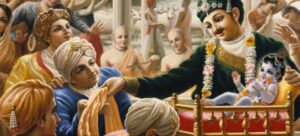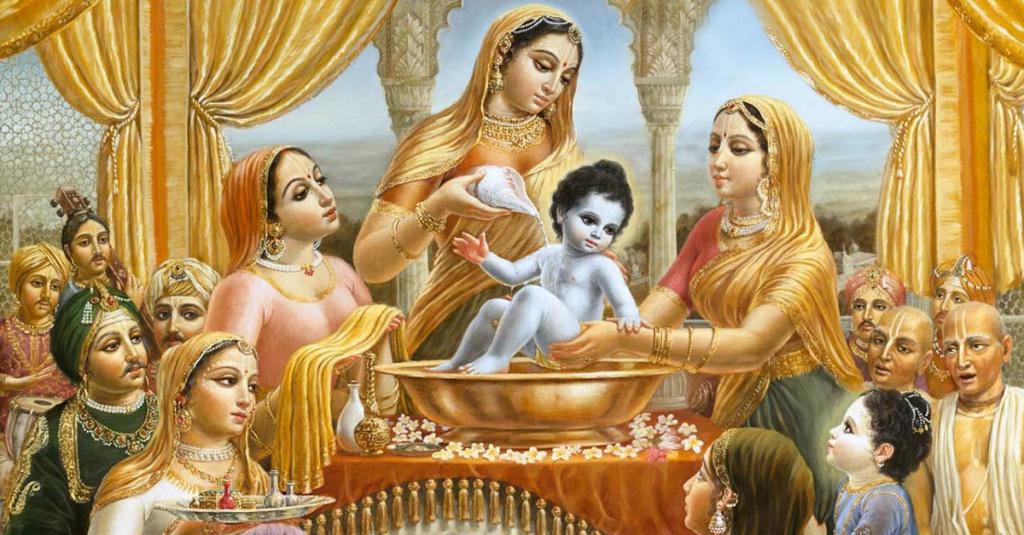Janmashtami

The celebrations at ISKCON revolve around the all-encompassing Lord Krishna, and Janmashtami is perhaps the biggest of them all. ISKCON Janmashtami celebration happens all across the world with great Devotion. Janmashtami refers to the day when the Appearance of Lord Krishna, the supreme Lord, is celebrated.
On this day, you will find that ISKCON temples around the globe are decorated and devotees come in large numbers to rejoice. A supremely auspicious day for Hare Krishna devotees, here now we will understand the meaning of Janmashtami in full depth.
On the day of Sri Krishna Janmashtami, it is imperative that you visit the temple. At the ISKCON Seshadripuram, the festivities are in full swing. The grand festival goes on for the entire day, and besides puja, there are a lot of other activities happening. ISKCON prepares Prasadam for devotees, which is first offered to the Supreme Lord as Bhoga, and then there are games and activities organized for children. The Deities of Radha Krishna are adorned with beautiful flowers, amazing ornaments, and celebrations of Janmashtami are conducted with love and devotion.
 What is the Story of Janmashtami?
What is the Story of Janmashtami?
The story of Janmashtami is the story of the Advent of Lord Krishna. It is celebrated each year on the eighth day of the Bhadrapada month. The Supreme Lord appeared in Mathura in a dungeon to Queen Devaki and King Vasudeva.
hen King Kamsa heard the prophecy, the eighth child born to Vasudeva and Devaki, would defeat Kamsa, This eighth child was none other than Lord Krishna. Kamsa became determined to destroy Krishna. Kamsa locked up Krishna’s parents in a prison, and there Krishna’s mother gave birth to seven children, six of whom died by Kamsa’s cruel hand.
One elder brother of Krishna’s eluded the sinful king. Known as Balarama, He is a plenary expansion of the Godhead. He transferred Himself to another location and waited for Krishna to also go there. Finally the eighth child of Devaki, Krishna, was born in the very dungeon of His family’s persecution.
Krishna entered this world through the heart of his father, Vasudeva, who had performed strong penances and austerities for thousands of years in his previous lifetimes. Vasudeva did this in order to achieve an intense meditation on the Lord by which He was able to attract Krishna to appear as his own son. Devaki, alongside her husband, had also engaged in long severe penances to attract the Lord. From Vasudeva’s heart Krishna was transferred to the womb of Devaki.
When Krishna first appeared to His parents, He showed Himself as the splendorous four-armed Lord Vishnu, upon whom they were accustomed to meditate. Mother Devaki prayed to Him:
Nandotsava
 Nandotsava is a festival celebrated following Krishna Janmashtami. The celebrations associated with the birth of Krishna find a new dimension in Vrindavan, the holy land where the Lord performed many leelas. The grand festivities continue in this holy town for six days when it transforms into Gokul. The celebrations last until the ‘Chhati Puja’, which is observed six days after the birth of Shri Krishna.
Nandotsava is a festival celebrated following Krishna Janmashtami. The celebrations associated with the birth of Krishna find a new dimension in Vrindavan, the holy land where the Lord performed many leelas. The grand festivities continue in this holy town for six days when it transforms into Gokul. The celebrations last until the ‘Chhati Puja’, which is observed six days after the birth of Shri Krishna.
When Bal Gopal was born, all the village folks of the Brajbhumi visited Nanda’s and Yashoda’s home to be a part of the festivities. Nandotsava is the observance of Krishna’s birth and holds a special significance in Vrindavan. It is a joyful event celebrated in every house in the holy town.
When baby Krishna sat on a golden throne, all the Braj Gopis came to worship the Lord in reverence and veneration. The loud beating of the bheri drums, the bol coming from the mandalas, the dexterous beats on the dholaks, and the sound of dhinta dhinta from the dundubhis and mridangas announced the auspicious birth of Yashoda Nandan. The blissful sounds of the drums and dundubhis were augmented by the animated voices and tinkling of the anklets of the Braj Gopis as they welcomed the guests visiting Nanda’s house.
Krishna Bathed in Pure Water
Yashoda Nandan was given a holy bath with rivulets of water pouring from crystal pitchers. The bathing ceremony purified the surroundings with immaculately articulated mantras. It added waves of magnetism to Shri Krishna’s already dynamic personality. After the ceremonial bath, Yashoda Nandan looked gorgeous after He was attired in a silk dhoti of brilliant yellow and chaddar, while He was adorned with gems, jewels, armbands, and bracelets.

